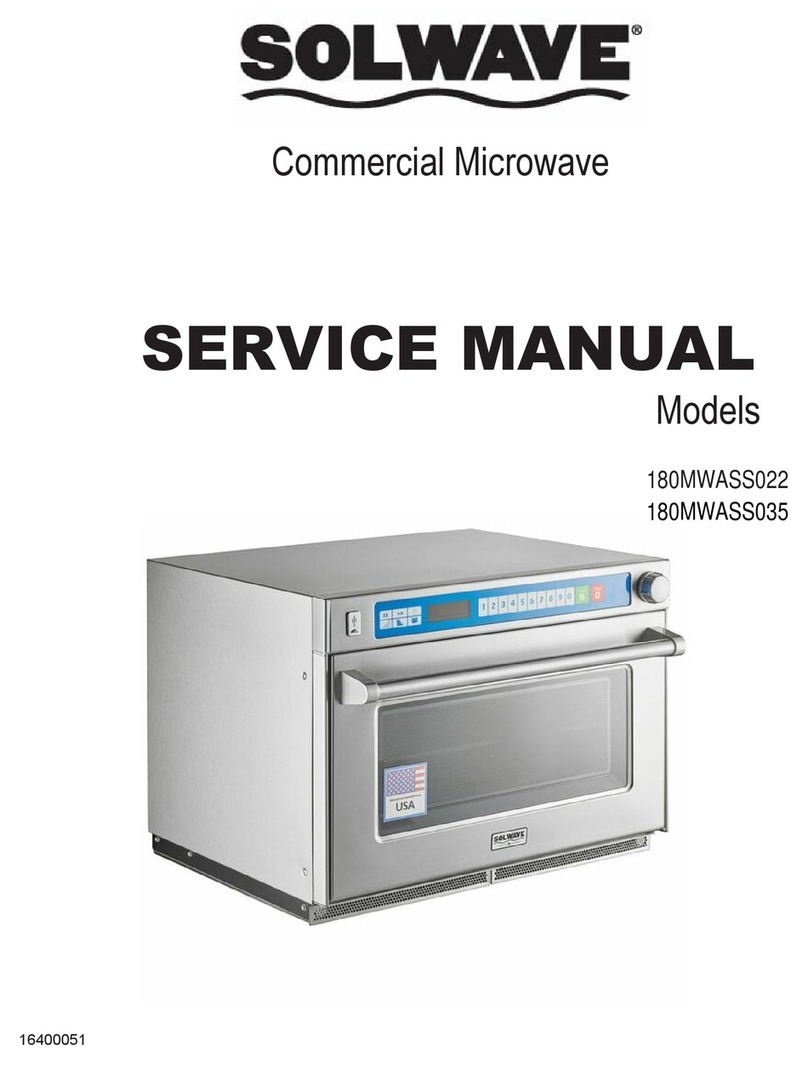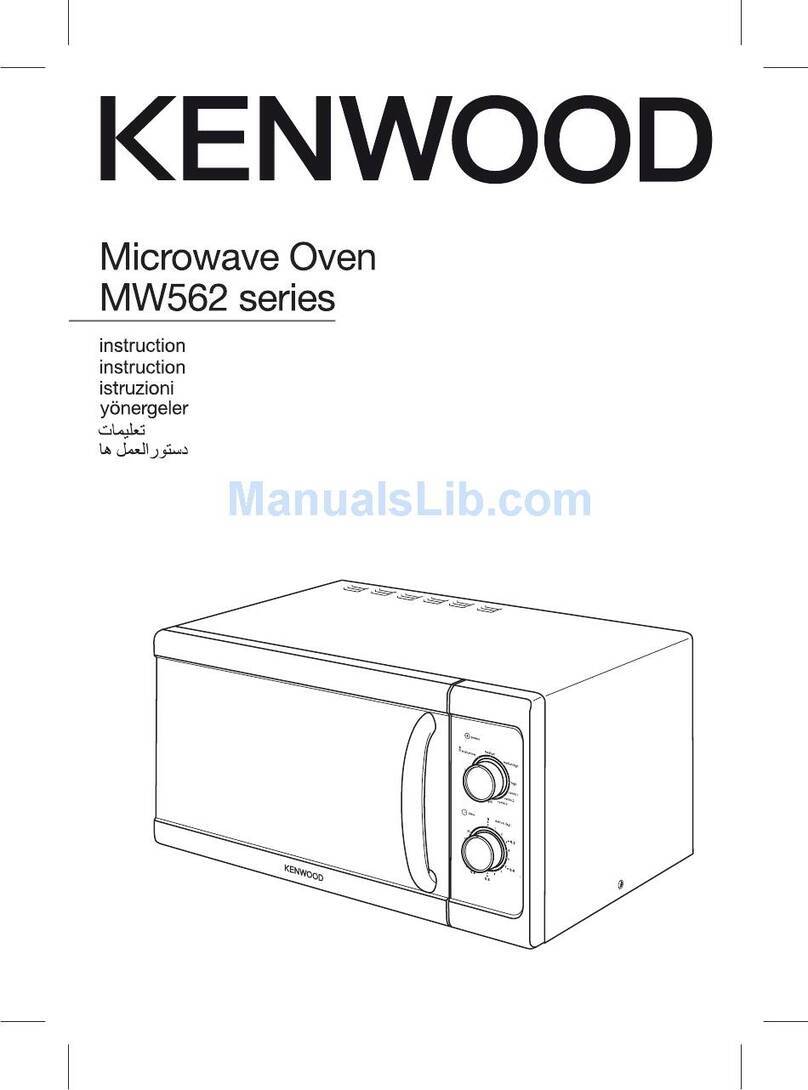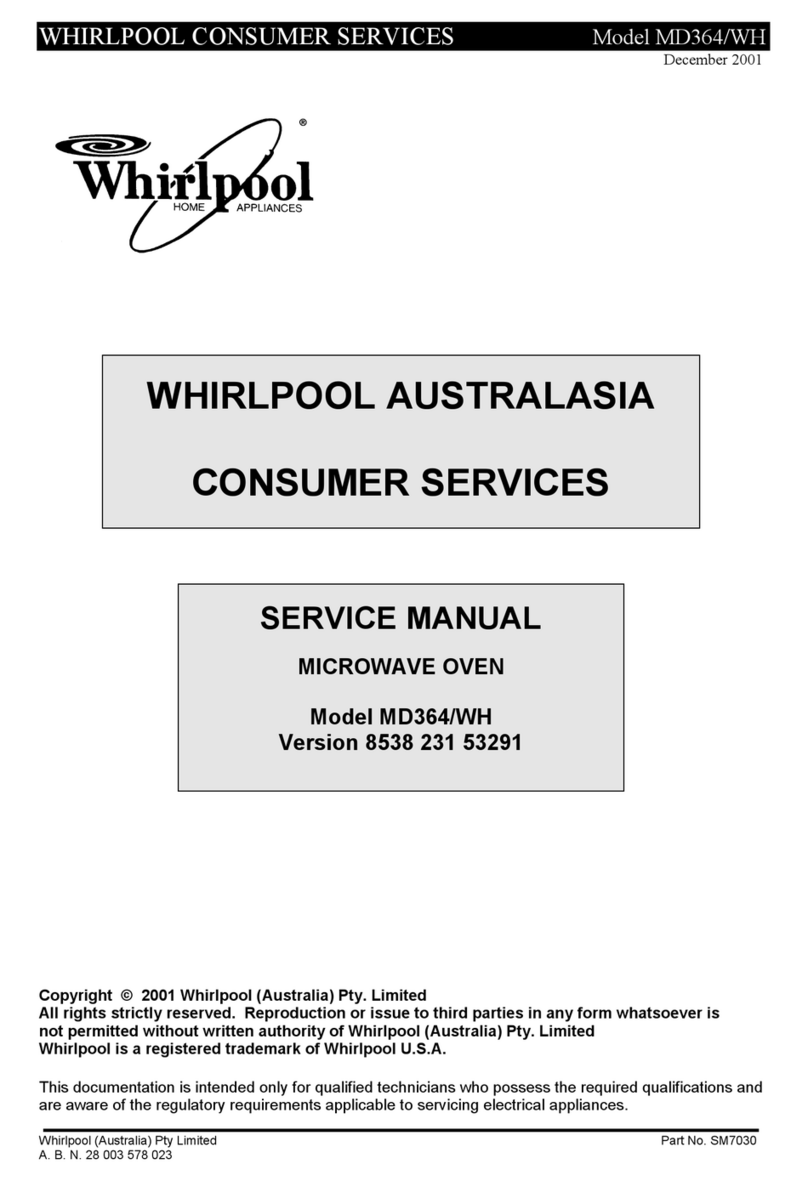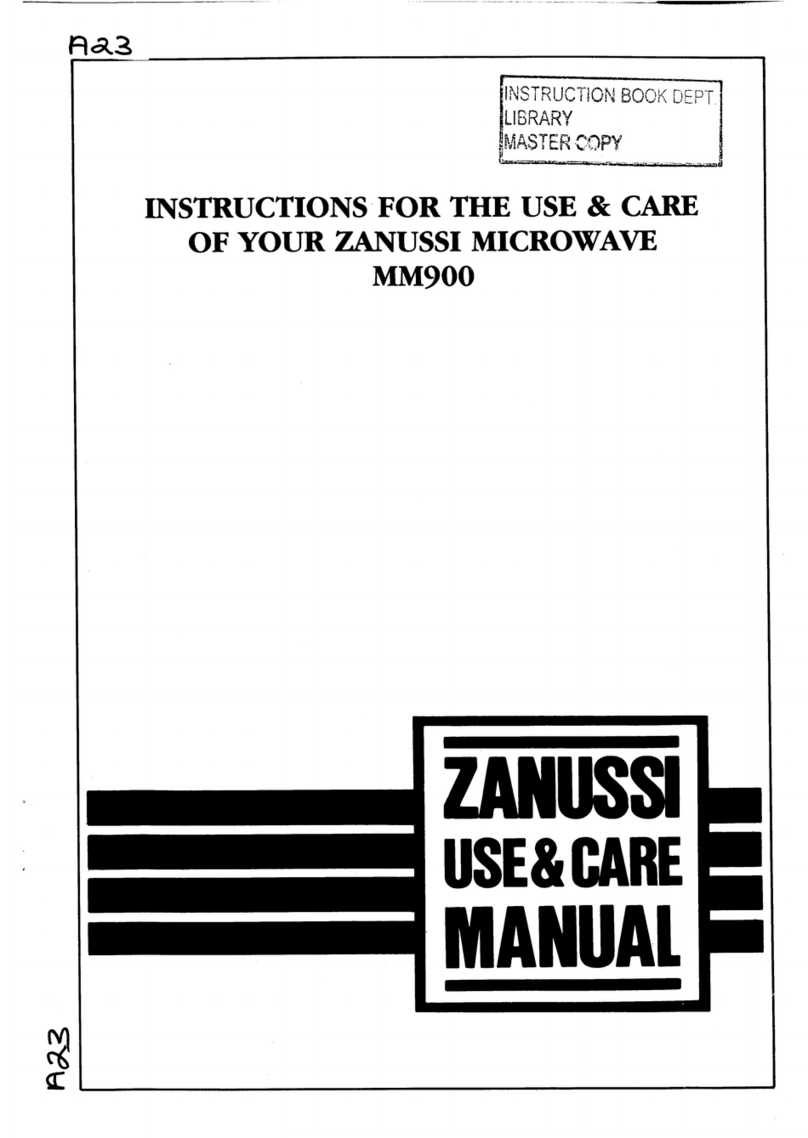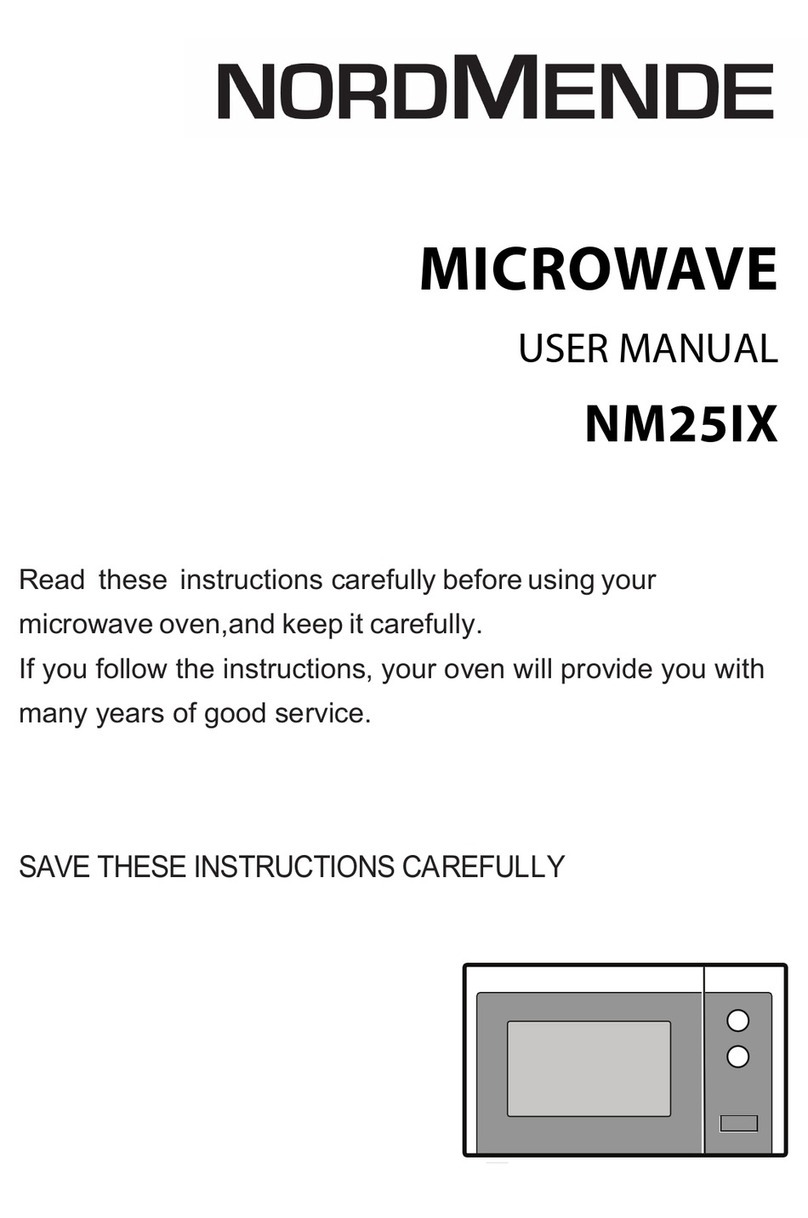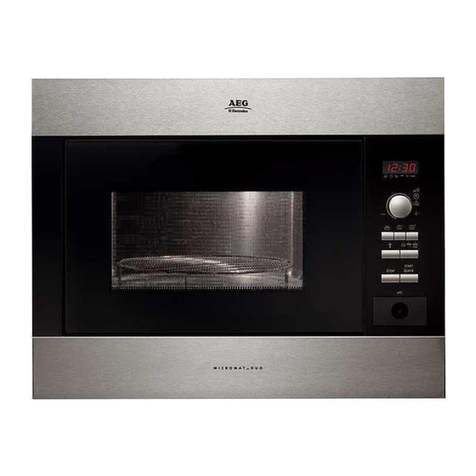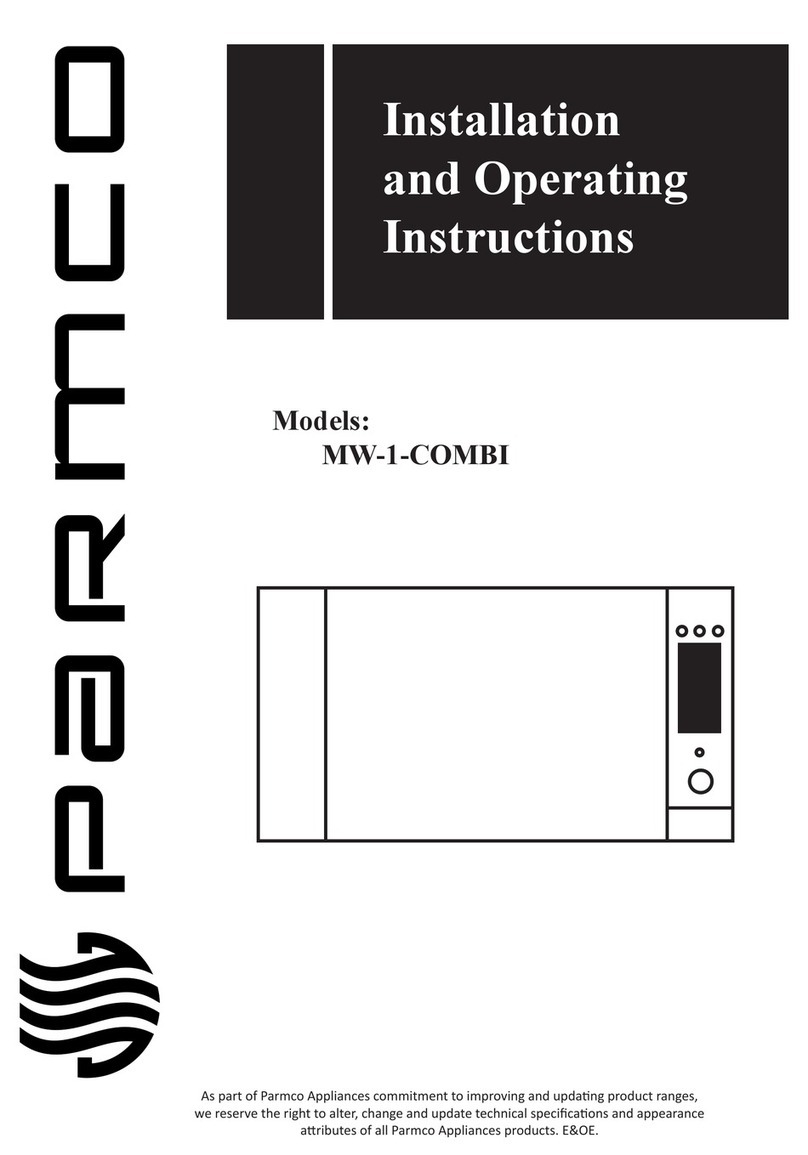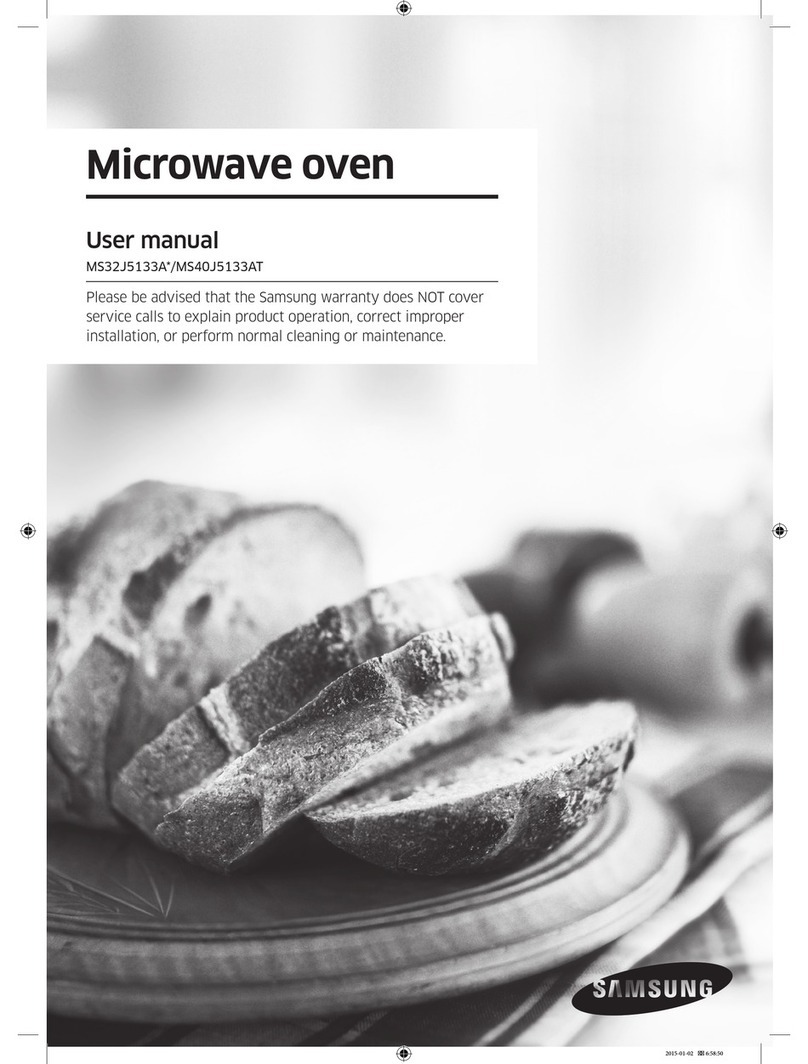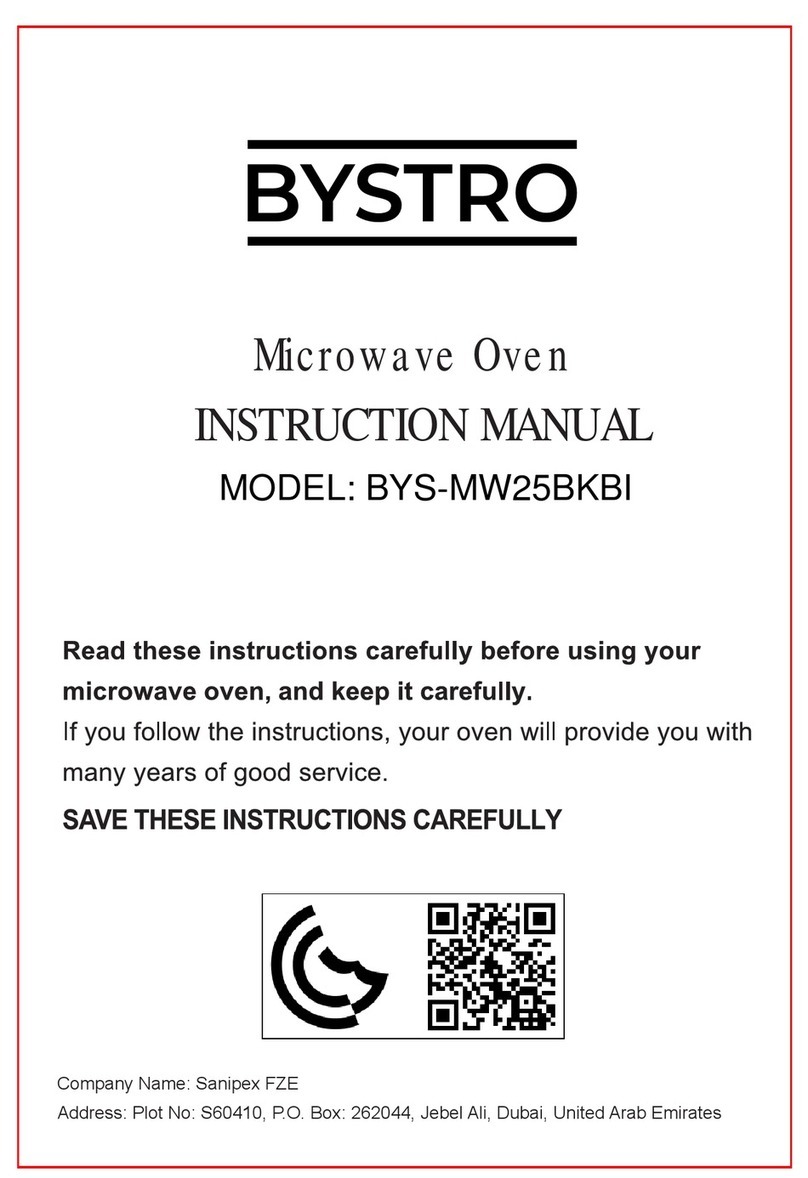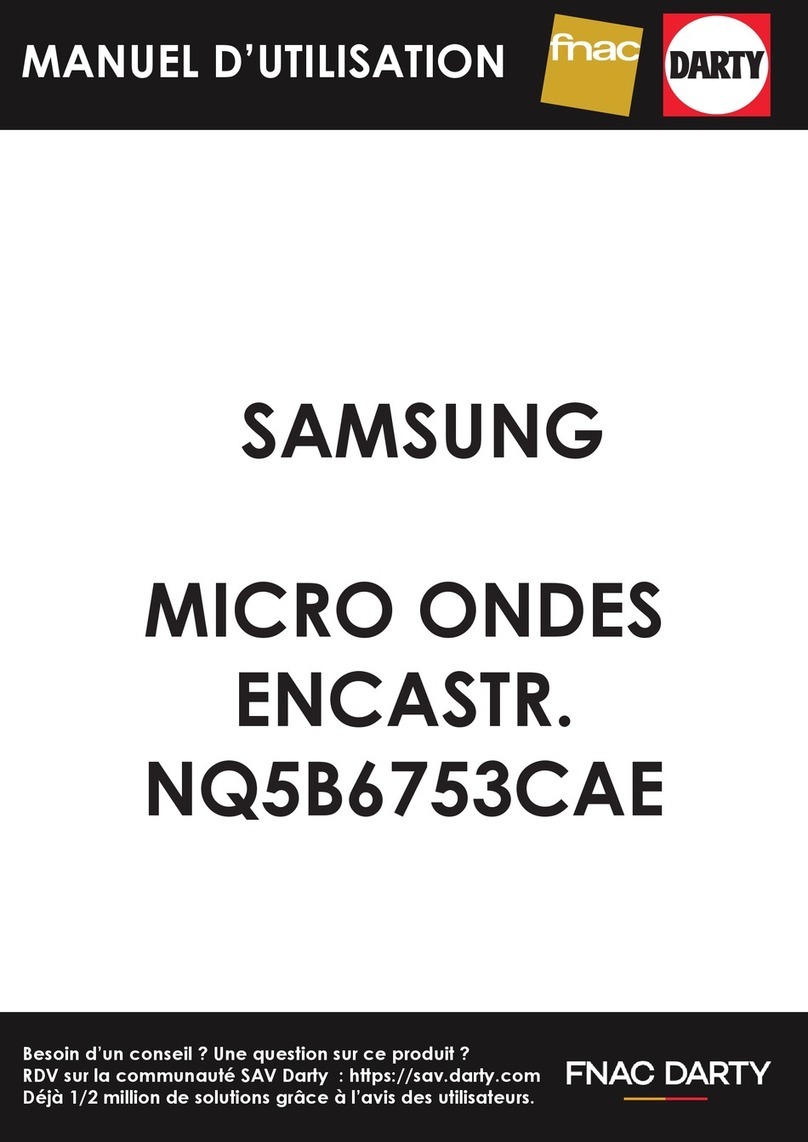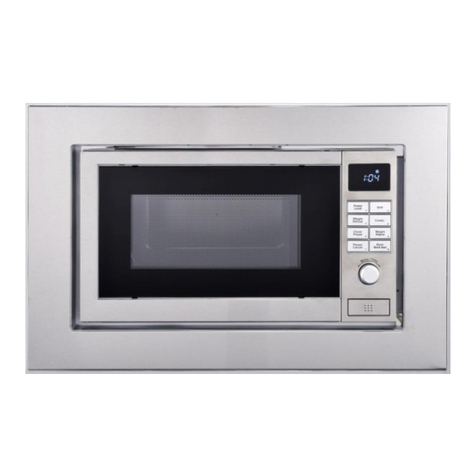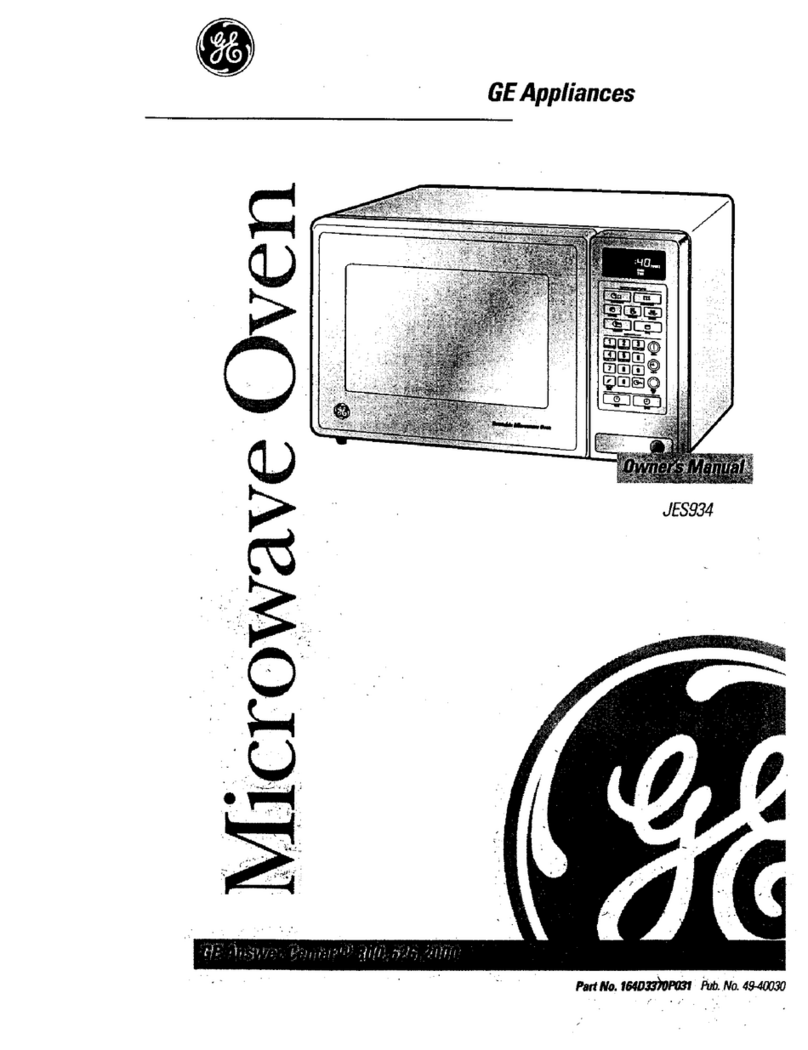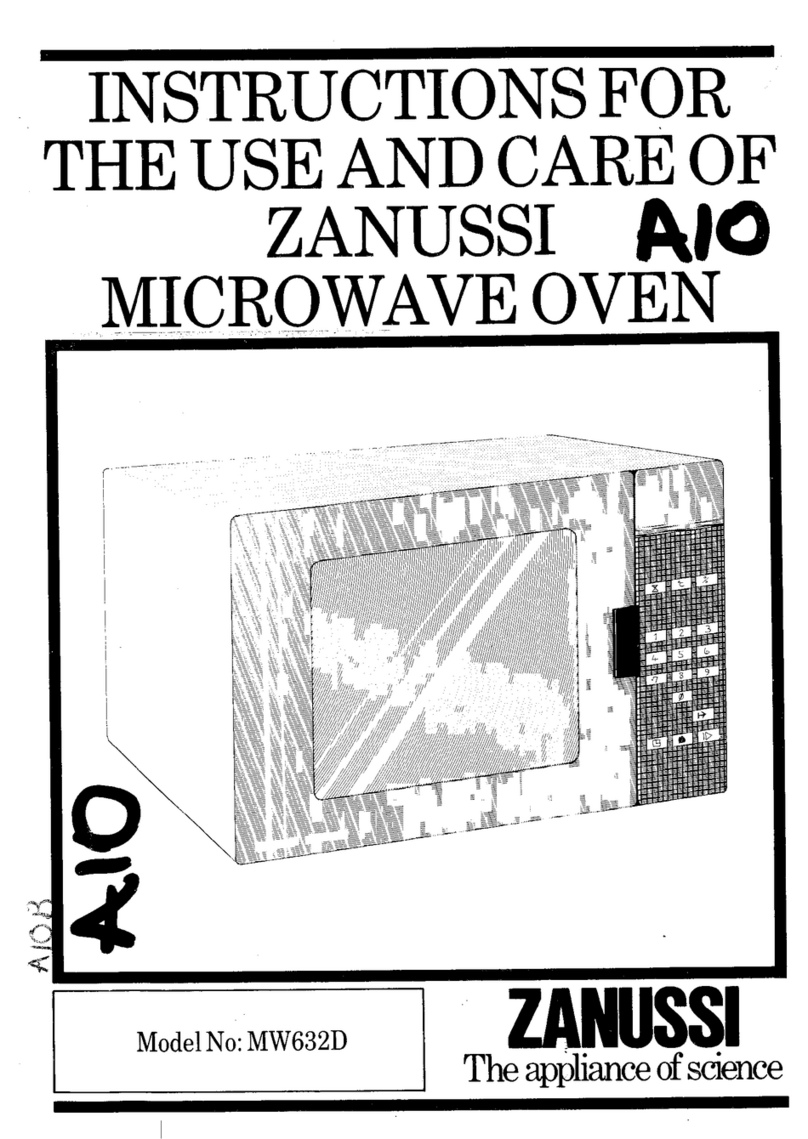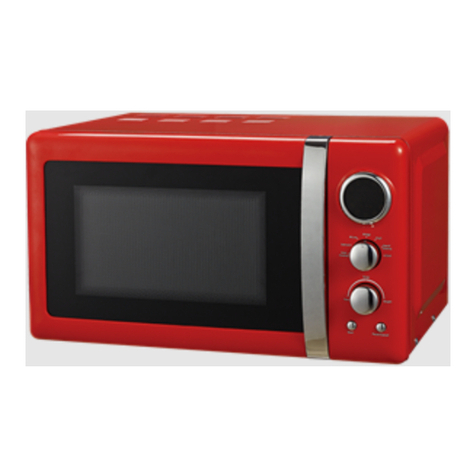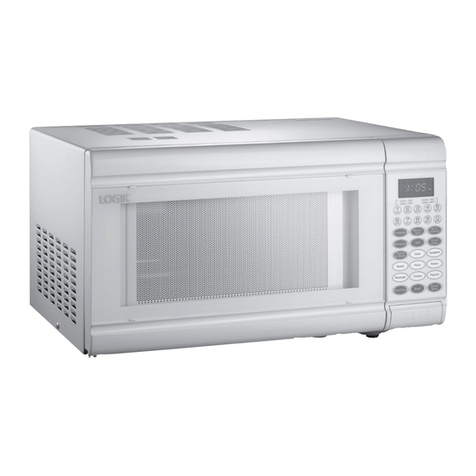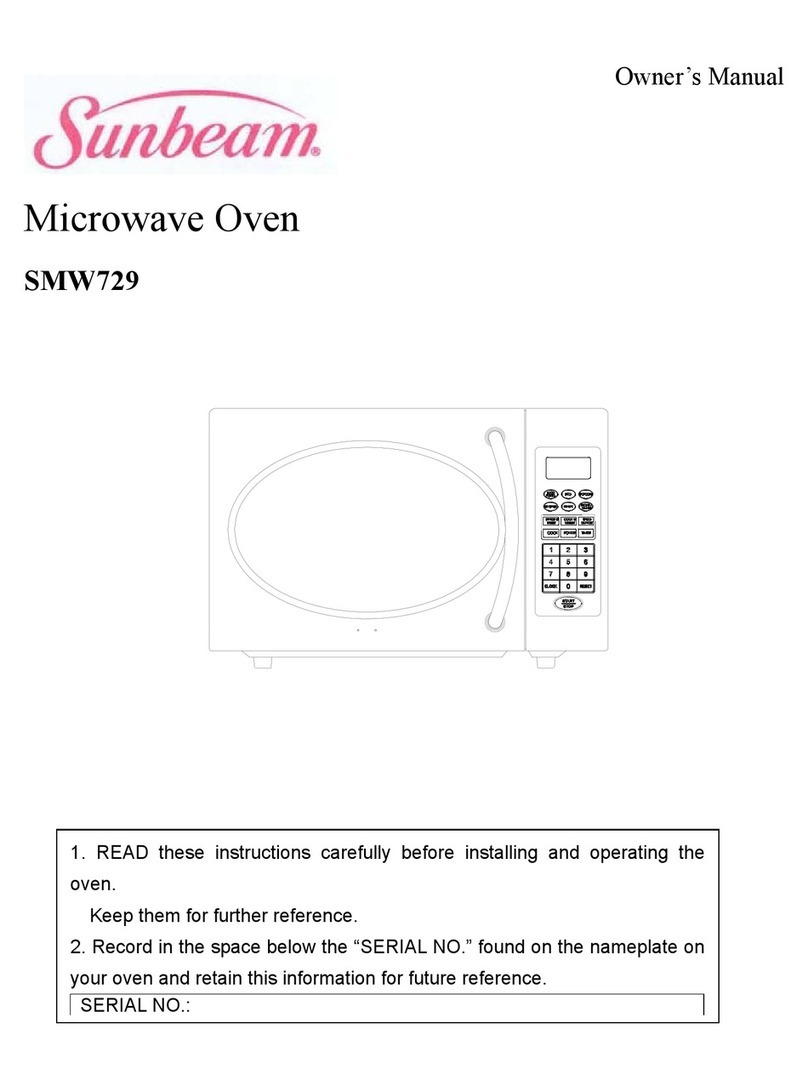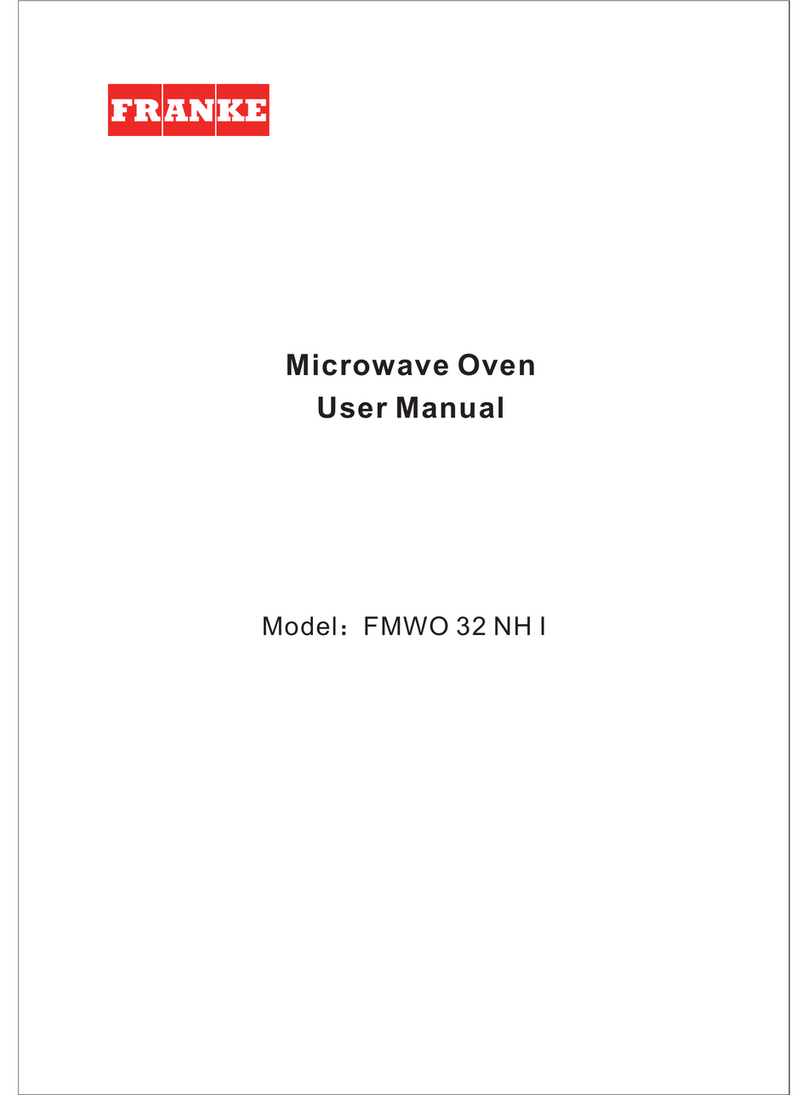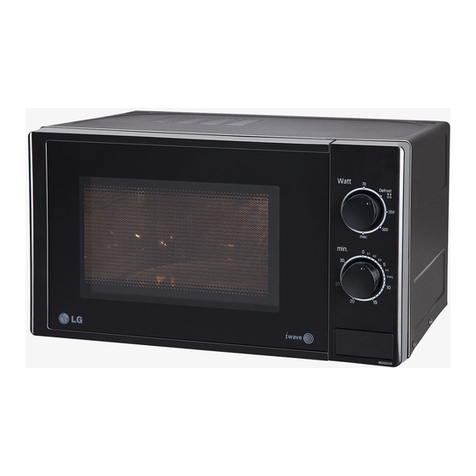Solwave 180MWAS12T User manual

Commercial Microwave
SERVICE MANUAL
Models
16400049
180MWAS12T
180MWAS18T
180MWAS21T

Table of Contents
Safety Information......................................................................................................2-4
Installation.................................................................................................................... 6
Specifications............................................................................................................... 7
Owner’s Information................................................................................................. 9-10
Components Locations. ..............................................................................................12
Disassembly.............................................................................................................. 14-15
Performance Testing Procedures. ...............................................................................17
Component Testing Procedures .............................................................................19-20
Error Codes. .............................................................................................................. 20
Service Test Mode . ................................................................................................... 20
Troubleshooting. ......................................................................................................... 22
Schematic / Wiring Diagrams.................................................................................24-25

1
1
Safety Information

2
Safety Information
!
WARNING
Read the following information to avoid possible exposure to microwave energy:
The basic design of the Microwave Oven makes it an inherently safe device to both use and service.
However,there are someprecautions whichshouldbefollowedwhen servicingthemicrowaveto maintainthis
safety. These are as follows:
1.
Always operate the unit from an adequately
grounded outlet. Do not operate on a two-wire
extension cord.
2.
Before servicingtheunit(ifunitisoperable)
perform the microwave leakage test.
3.
Theovenshouldneverbeoperatedifthedoordoes
not fit properly against the seal, the hinges or hinge
bearings are damaged or broken; the choke is
damaged, (pieces missing, etc.); or any other
visible damage can be noted. Check the choke
areato ensurethat this area is clean andfree ofall
foreignmatter.
4.
If the oven operates with the door open and
producesmicrowaveenergy, take thefollowing
steps:
A.
Tell the user not to operate the oven.
B.
ContactSOLWAVE immediately.
5.
Alwayshavetheovendisconnectedwhentheouter
case is removed except when making the "live"
tests called for in the Service Manual. Do not
reach into the equipment area while the unit is
energized. Make all connections for the test and
check them for tightness before plugging the cord
into theoutlet.
6.
Always ground the capacitors on the magnetron
filter box with an insulated-handle screwdriver
before working in the high voltage area of the
equipment compartment. Some types of failures
will leave a charge in these capacitors and the
discharge couldcause areflex actionwhich could
make you injure yourself.
7.
Always remember that in the area of the
transformer there is HIGH VOLTAGE. When the
unit is operating keep this area clear and free of
anything which could possibly cause an arc or
ground, etc.
8.
Do not for any reason defeat the interlock
switches there is not valid reason for this action
at any time.
9.
IMPORTANT: Before returning a unit to a
customer, be sure to check for proper switch
interlock action.
10.
The MicrowaveOven shouldnever be
operated with any components removed and/or
bypassed orwhen any ofthe safety interlocksare
found to be defective, or when any of the seal
surfacesaredefective,missing,ordamaged.
11.
All microwave ovens meet all requirements
ofthe radiation control for Healthand SafetyAct of
1968. Due to measurement uncertainties, the
maximum leakage for the field will be 4mw/cm2.
12.
To ensure that the unit does not emit excessive
microwave leakage and to meet the Department
ofHealthand HumanServicesguidelines,check
theovenformicrowaveleakageusingamicrowave
oven leakage meter that complies with US
GovernmentCDRH/ FDA/ DHHSrequirements
and or any other local government requirements.
The maximum leakage level allowed by
manufacturer
is 4mw/cm 2.
13.
If servicer encounters an emission reading
over
4mw/cm2, the servicer is to cease
repair and contact SOLWAVE
immediately for further direction.
SOLWAVE will contact the proper
Government Agencyuponverificationof
thetestresults.

3
Recognize this symbol as a SAFETY message
!
WARNING
When using electrical equipment, basic safety precautions should be followed to reduce the risk of burns,
electrical shock, fire, or injury to persons including the following.
1. READ all instructions before using equipment.
2. READ AND FOLLOW the specific
“PRECAUTIONS TO AVOID POSSIBLE
EXPOSURE TO EXCESSIVE MICROWAVE
ENERGY” on this page.
3. This equipment MUST BE GROUNDED. Connect
only to properly GROUNDED outlet. See “
GROUNDING / EARTHING INSTRUCTIONS”.
4. Install or locate this equipment ONLY in
accordance with the installation instructions in
this manual.
5. Some products such as whole eggs and sealed
containers—for example, closed glass jars—are
able to explode and SHOULD NOT be HEATED
in this oven.
6. Use this equipment ONLY for its intended use as
described in this manual. Do not use corrosive
chemicals or vapors in this equipment. This type
of oven is specifically designed to heat, cook,
or dry food. It is not designed for industrial or
laboratory use.
7. As with any equipment, CLOSE SUPERVISION
is necessary when used by CHILDREN.
8. See door cleaning instructions
9. DO NOT heat baby bottles in oven.
10. Baby food jars shall be open when heated and
contents stirred or shaken before consumption, in
order to avoid burns.
11 DO NOT operate this equipment if it has a
damaged cord or plug, if it is not working properly,
or if it has been damaged or dropped.
12. This equipment, including power cord, must be
serviced ONLY by qualified service personnel.
Special tools are required to service equipment.
Contact nearest authorized service facility for
examination, repair, or adjustment.
13. DO NOT cover or block louvers or other openings
on equipment.
14. DO NOT store this equipment outdoors. DO NOT
use this product near water – for example, near a
kitchen sink, in a wet basement, a swimming pool,
or a similar location.
15. DO NOT immerse cord or plug in water.
16. Keep cord AWAY from HEATED surfaces.
17. DO NOT let cord hang over edge of table or
counter.
18. For commercial use only.
PRECAUTIONS TO AVOID POSSIBLE
EXPOSURE TO EXCESSIVE MICROWAVE ENERGY
A. DO NOT attempt to operate this oven with the door open since open door operation can result in harmful
exposure to microwave energy. It is important not to defeat or tamper with the safety interlocks.
B. DO NOT place any object between the oven front face and the door to allow soil or cleaner residue to
accumulate on sealing surfaces.
C. DO NOT operate the oven if it is damaged. It is particularly important that the oven door close properly and
that there is no damage to the:
1. door (bent)
2. hinges and latches (broken or loosened)
3. door seals and sealing surfaces.
D. The oven should not be adjusted or repaired by anyone except properly qualified service personnel.

4
To avoid personal injury or property damage, observe the following:
1. Do not deep fat fry in oven. Fat could overheat
and be hazardous to handle.
2. Do not cook or reheat eggs in shell or with
an unbroken yolk using microwave energy.
Pressure may build up and erupt. Pierce yolk
with fork or knife before cooking.
3. Pierce skin of potatoes, tomatoes, and similar
foods before cooking with microwave energy.
When skin is pierced, steam escapes evenly.
4. Do not operate equipment without load or food
in oven cavity.
5. Microwave popcorn should not be popped in
oven.
6. Do not use regular cooking thermometers in
oven. Most cooking thermometers contain
mercury and may cause an electrical arc,
malfunction, or damage to oven.
7. Do not use metal utensils in oven.
8. Do not use aluminum foil in oven
9. Never use paper, plastic, or other combustible
materials that are not intended for cooking.
10. When cooking with paper, plastic, or other
combustible materials, follow manufacturer’s
recommendations on product use.
11. Do not use paper towels which contain nylon or
other synthetic fibers. Heated synthetics could
melt and cause paper to ignite.
12. Do not heat sealed containers or plastic bags in
oven. Food or liquid could expand quickly and
cause container or bag to break. Pierce or open
container or bag before heating.
13. To avoid pacemaker malfunction, consult
physician or pacemaker manufacturer about
effects of microwave energy on pacemaker.
14. An authorized servicer MUST inspect equipment
annually. Record all inspections and repairs for
future use.
To avoid risk of fire in the oven cavity:
a. DO NOT overcook food. Carefully attend oven
when paper, plastic, or other combustible
materials are placed inside the oven to facilitate
cooking.
b. Remove wire twist-ties from paper or plastic
bags before placing bag in oven.
c. If materials inside the oven ignite, keep oven
door CLOSED, turn oven off and disconnect
the power cord, or shut off power at the fuse or
circuit breaker panel.
d. DO NOT use the cavity for storage. DO NOT
leave paper products, cooking utensils, or food
in the cavity when not in use.
WARNING
Liquids such as water, coffee, or tea are able to
be overheated beyond the boiling point without
appearing to be boiling due to surface tension of the
liquid. Visible bubbling or boiling when the container
is removed from the microwave oven is not always
present. THIS COULD RESULT IN VERY HOT
LIQUIDS SUDDENLY BOILING OVER WHEN A
SPOON OR OTHER UTENSIL IS INSERTED INTO
THE LIQUID. To reduce the risk of injury to persons:
i) Do not overheat the liquid.
ii) Stir the liquid both before and halfway through
heating it.
iii) Do not use straight-sided containers with narrow
necks.
iv) After heating, allow the container to stand in the
microwave oven for a short time before removing
the container.
v) Use extreme care when inserting a spoon or
other utensil into the container.
WARNING

5
Model Specifications
Installation
·
Unpacking the oven
·
Radio Interference
·
Oven Placement
Specification
·
Input- Power Source
·
Output- Power Source
·
Power Consumption
·
Cavity Dimension
·
Weight
2

6
Installation
Unpacking Oven
• Inspect oven for damage such as dents in door or
dents inside oven cavity.
• Report any dents or breakage to source of purchase
immediately. Do not attempt to use oven if damaged.
• Remove all materials from oven interior.
• If oven has been stored in extremely cold area, wait a
few hours before connecting power.
Radio Interference
Microwave operation may cause interference to radio,
television, or a similar oven. Reduce or eliminate
interference by doing the following:
• Clean door and sealing surfaces of oven according to
instructions in Owner’s Manual.
• Place radio, television, etc. as far as possible
from oven.
• Use a properly installed antenna or cable on radio,
television, etc. to obtain stronger signal reception.
Oven Placement
• Do not install oven next to or above source of heat,
such as pizza oven or deep fat fryer. This could cause
microwave oven to operate improperly and could
shorten life of electrical parts.
• Do not block or obstruct oven filter. Allow access for
cleaning.
• Install oven on level countertop surface.
A- Allow at least 2 in / 5.1 cm of clearance
around top and sides of equipment.
Proper air flow around equipment cools
electrical components. With restricted
air flow, oven may not operate properly
and the life of electrical parts is
reduced.
B -There is not an installation clearance
requirement for the back of the oven
C – Allow at least 1 in / 2.54 cm clearance
around sides of oven
•Oven stacking is allowed using stacking
bracket located on oven back panel top hinge
side corner
•Using stacking brackets on back panel of
ovens remove screws from stacking brackets
and reattach them to back panel between both
ovens securing them together using back
panel screws

7
Specifications
Power Source
Voltage AC
120V
208-240V
208-240V
Amperage
16A
20A
20A
Frequency
60 Hz
60 Hz
60 Hz
Single Phase, 3
wire grounded
Yes
Yes
Yes
Plug Configuration /
Cord
NEMA 5-20
NEMA 6-20
NEMA 6-20
Power Output
Nominal
microwave
energy
(IEC705)
1200W
1800W
2100W
Minimum
temperature rise
12°F / 6.5°C
18°F / 7.7°C
21°F / 11.5°C
Operating
Frequency
2450 MHz
2450 MHz
2450 MHz
Power
Consumption
16A
13.5A
15.5A
Cook Condition
Microwave
2000W
2800W
3200W
Dimensions
Cabinet
Width
21 3/4” (551)
21 3/4” (551)
21 3/4” (551)
Height
14 3/8” (365)
14 3/8” (365)
14 3/8” (365)
Depth
21” (533)
21” (533)
21” (533)
Cavity Dimensions – 1.2 cu ft
Width
14 1/8” (359)
14 1/8” (359)
14 1/8” (359)
Height
8 7/8” (226)
8 7/8” (226)
8 7/8” (226)
Depth
16 1/4” (413)
16 1/4” (413)
16 1/4” (413)
Weight
Crated
71 lbs. (32 kg)
77 lbs. (35 kg)
77 lbs. (35 kg)
Uncrated
66 lbs. (30 kg)
70 lbs. (32 kg)
70 lbs. (32 kg)
Models 180MWAS12T 180MWAS18T 180MWAS21T

8
Owner’s Information
Clean Filter
Control Panel
·
Manual Operation
·
Programming Items
User Options
·
Changing Options
3

9
Owner’s Information
CLEAN FILTER
This oven displays
CLEAN FILTER
at user
defined intervals. When the message
displays SOLWAVE recommends
cleaning the air filter thoroughly.
Cleaning the air filter will not shut off
the message.
The message will stop displaying
automatically after 24 hours. Depending
on microwave use and environmental
conditions, the filter may need to be
cleaned more frequently. Once the
frequency is determined, set the option
for
the appropriate time frame.
Preprogrammed
Pads
To cook food
using preprogrammed
cooking sequences:
1. Open oven door and place food
in oven. Close door.
2. Press desired pad.
3. Oven begins to cook.
4. At end of cooking cycle oven
beeps and shuts off.
X2
Programming
(if equipped)
To change the cooking factor:
1. Open oven door.
2. Press and hold pad 1 for
approximately 5seconds.
3. Press pad to bereprogrammed.
4. Press the QTY 2X pad.
5. Press a numbered pad to
change the cookingfactor.
• Cooking factor can be set from
10% to 100%.
• Default is 80%.
• Pad 5 would changethe
cooking factor to 50%.
6. Press START pad tosave
changes.
Electronic Control
Manual Operation
To cook food using a specific entered time and power level:
1. Open oven door and place food in oven. Close door.
2. Press TIME ENTRY pad and enter cooking time.
3. Press a power level pad to change power level if desired (some
models).
•
COOK LEVEL
displays with the power setting.
4. If stage cooking is desired, press TIME ENTRY pad and repeat steps
2 through 4, (some models).
5. Press START pad.
6. At end of cooking cycle oven beeps and shuts off.
Programming Items
1. Open oven door.
2. Press and hold pad 1 for approximately 5 seconds.
3. Press pad to be reprogrammed.
4. Enter cooking time by using the number pads.
5. Press a power level pad to change power level ifdesired.
6. If stage cooking is desired, press TIME ENTRY pad.
• Display briefly shows the stage number.
• Display changes to cook time and power level for the next stage.
7. Enter cook time and power level as in steps 4 and 5 (some models).
• To enter another cooking stage for that pad, press TIME ENTRY pad
again.
• Up to four different stages can be programmed (some models).
8. Press START pad to set new programming changes to the pad.
NOTE:
To discard changes, press STOP/RESET pad or close oven door.
X2 Pad (if equipped)
1. Open oven door and place food in oven. Close door.
2. Press QTY 2X pad.
3. Press desired preprogrammed pad or pad sequence.
4. Oven begins cooking. Displayed cooking time is the total of original
cooking time and added 2X time.
The switching operation of this microwave oven can cause voltage fluctuations on the supply line. The operation of this oven under
unfavorable voltage supply conditions can have adverse effects. This device is intended for the connection to a power supply system
with a maximum permissible system impedance Zmax of
0.2 Ohms
at the interface point of the user’s supply. The user has to
ensure that this device is connected only to a power supply system which fulfills the requirement above. If necessary, the user
can ask the public power supply company for the system impedance at the interface point.
7

10
DO NOT power spray
No metal pans
Options such as single or double digit programming, beep volume, and
maximum cooking time can be changed to suit individual preferences.
To change options:
1. Open oven door.
• If door is closed or RESET pad is pressed before programming is complete,
changes are discarded and microwave exits programming mode.
2. Press and hold pad 2 for approximately 5 seconds.
• This begins options mode.
• Microwave will beep and 0P: displays.
3. Press number pad that controls option to be changed.
• See table below for options.
• Current option will display.
4. Press number pad again to change the option.
• Each time pad is pressed, option will change.
• Match code displayed with code for desired option.
5. Press START pad to save changes.
• To change additional options, repeat steps 3 and 4.
• Changes appear after door is closed or STOP/RESET pad is pressed.
Numbered Pads
Display
Options
1
End of Cycle Beep
OP:10
OP:11
OP:12
3 second beep.
Continuous beep until door is opened.
5 beep bursts until door is opened.
2
OP:20
Eliminates beep.
Key Beep Volume
OP:21
Sets volume to low.
OP:22
Sets volume to medium.
OP:23
Sets volume to high.
3
Key Beep
OP:30
OP:31
Prevents beep when pad is pressed.
Allows beep when pad is pressed.
4
Active Display
OP:40
OP:41
OP:42
15 seconds after oven door is opened, keyboard disabled.
30 seconds after oven door is opened, keyboard disabled.
1 minute after oven door is opened, keyboard disabled.
OP:43
2 minutes after oven door is opened, keyboard disabled.
5
On-the Fly Cooking
OP:50
OP:51
Prevents
Allows
.
.
6
Reset to Ready Mode
OP:60
OP:61
Opening oven door does not reset oven back to ready mode.
Opening oven door resets oven back to ready mode.
7
(some models)
MaximumHeatingTime
OP:70
OP:71
Allows 60 minutes of heating time (some models).
Allows 10 minutes of heating time.
8
Manual Operation
OP:80
OP:81
Allows use of preprogrammed pads only.
Allows use of manual time entry and preprogrammed pads.
9
(some models)
Double Digit Operation
OP:90
OP:91
Allows 10 (0-9) preprogrammed pads.
Allows 100 (00-99) preprogrammed pads.
0
OP:00
Do not display message.
Clean Filter Message
OP:01
Display message for 24 hours every 7 days.
OP:02
Display message for 24 hours every 30 days.
OP:03
Display message for 24 hours every 90 days.

11
4
Components Location

12
Components Location

13
Disassembly
Door Removal
·
Disassembly
Control Removal
·
Wire terminals
5

14
Disassembly
Door Removal
1.
Disconnect power tooven.
2.
Open oven door, remove top hinge cap, and slowly lift door to disengage the hinge pins at top and bottom.
3.
To reinstall door, place top pin into slot first, then align bottom pin.
4.
Reinstall top hinge cap.
Choke
cover
Outer
Door
panel
Latch
assembly
* Door
Handle
Doorframe/
Spring
choke assembly
*Apply thread lock compound to threads, tighten side screw first.
Top
cap

15
Control Panel Removal
1.
Disconnect power to oven and remove outer case.
2.
Disconnect and label wires from controller/timer.
3.
Open oven door.
4.
Remove screw securing top of control panel to cavity. Lift control panel up and out to release tabs.
Disconnecting Wire Terminals
All wire terminals are locking-type terminals.
Proceed as follows to disconnect wire terminals:
Insulated terminals:
Grasp insulator and pull back. DO NOT PULL ON WIRE.
Non-insulated terminals:
Use a small blade screwdriver to depress locking-tab and pull on terminal. DO NOT PULL ON WIRE.
2 Pull
Pod
1 Grasp
1
Release
locking-tab
2 Pull

16
Performance Testing
6

17
Performance Testing
All SOLWAVE microwave oven power outputs are rated using the IEC705 standards. Using the IEC705 test
method requires precision measurements and equipment that is not practical to be performed in the field. Using
the test shown below will indicate if the oven performance is satisfactory.
Test equipment required:
•
1000 ml test container and thermometer.
•
Digital watch / watch with a second hand for use on ovens with electromechanical timers.
Important Notes:
•
Low line voltage will cause low temperature rise / power output.
•
Ovens must be on a dedicated circuit, properly grounded, and polarized. Other equipment on the same
circuit may cause a low temperature rise / power output.
•
This test and results are not a true IEC705 test procedures and are only intended to provide servicers with
an easy means of determining if the microwave oven cooking output is correct.
Procedure
1.
Determine correct Power Output Wattage by referring to Model/Serial tag.
2.
Fill the test container to the 1000 ml line with cool tap water.
NOTE: Water temperature should be approximately 65°F / 16°C
3.
Using the thermometer, stir water for five to ten seconds; measure, and record the temperature (T1).
4.
Place test container of water in the center of oven cavity and close door.
5.
Heat the water for a 33-second full power cycle.
NOTE: Use a digital watch or a watch with a second hand for ovens with electromechanicaltimers.
6.
At end of the cycle, remove test container. Using the thermometer, stir water for five to ten seconds and record
temperature (T2).
7.
Subtract the starting water temperature (T1), from the ending water temperature (T2) to obtain the temperature
rise (∆T).
8.
If the temperature rise (∆T) meets or exceeds the minimum, the test is complete. If the temperature rise (∆T)
fails to meet the minimum temperature rise, test the line voltage to verify it is correct. Then repeat steps 1 - 6
making sure to change the water. If the temperature rise (∆T) fails to meet the minimum temperature rise again
the oven will require service.
Minimum Temperature Rise at Thirty -Three (33) Seconds Run Time
∆T Cooking
(°F) Power Output
∆T Cooking
(°F) Power Output
∆T Cooking
(°C) Power Output
∆T Cooking
(°C) Power Output
10 ................. 1000
20 ................. 2000
5 .............. 1000
11............ 2000
11 ................. 1100
21 ................. 2100
5.5 ............ 1100
11.5......... 2100
12 ................. 1200
22 ................. 2200
6.5 ............ 1200
12............ 2200
14 ................. 1400
24 ................. 2400
7.5 ............ 1400
13............ 2400
17 ................. 1700
25 ................. 2500
9.5 ............ 1700
13.5......... 2500
18 ................. 1800
27 ................. 2700
10 ............. 1800
15............ 2700
19 ................. 1900
30 ................. 3000
10.5 .......... 1900
16.5......... 3000
To avoid risk of electrical shock, personal injury or death, disconnect power to oven and discharge capacitor
before servicing, unless testing requires it.

18
Component Specifications
7
This manual suits for next models
2
Table of contents
Other Solwave Microwave Oven manuals
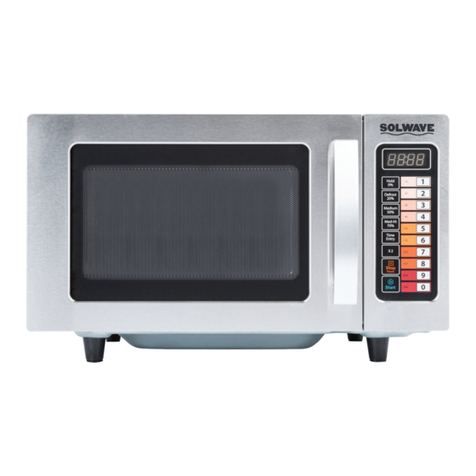
Solwave
Solwave 180MW1000SS User manual

Solwave
Solwave 180MW1000D User manual
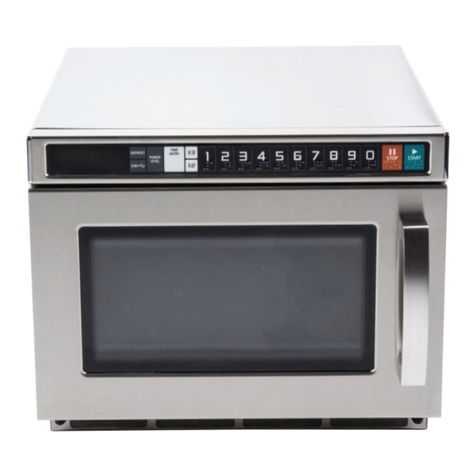
Solwave
Solwave 180MWHD12 User manual
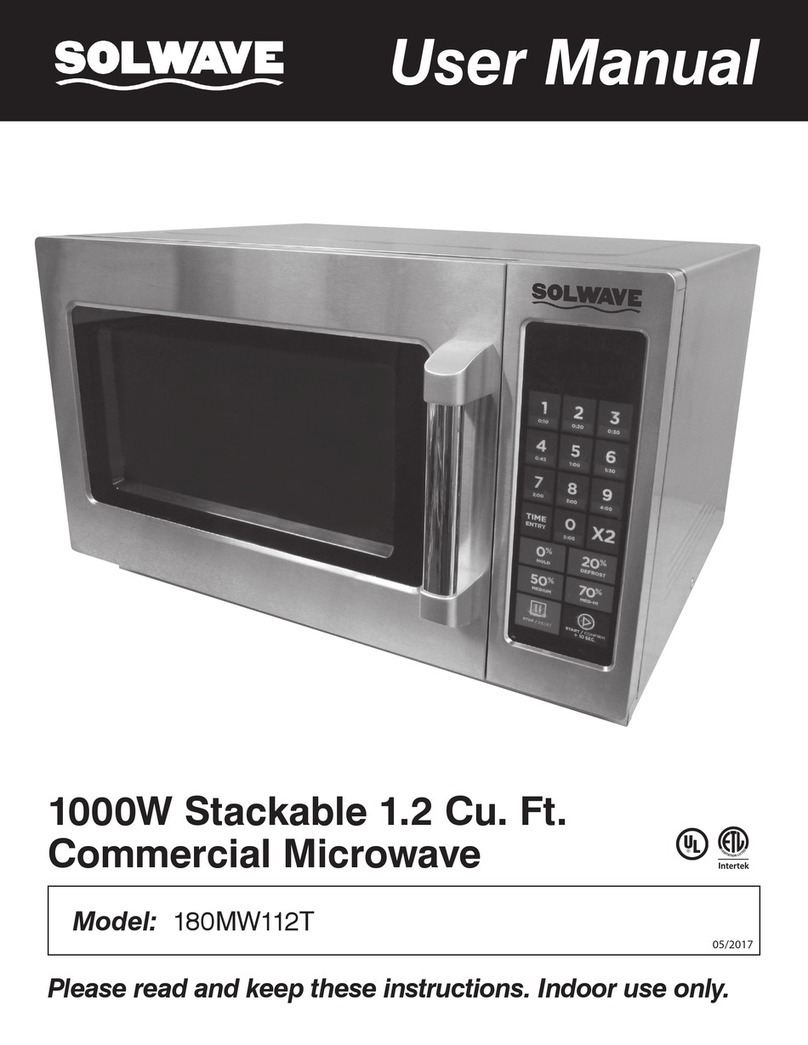
Solwave
Solwave 180MW112T User manual
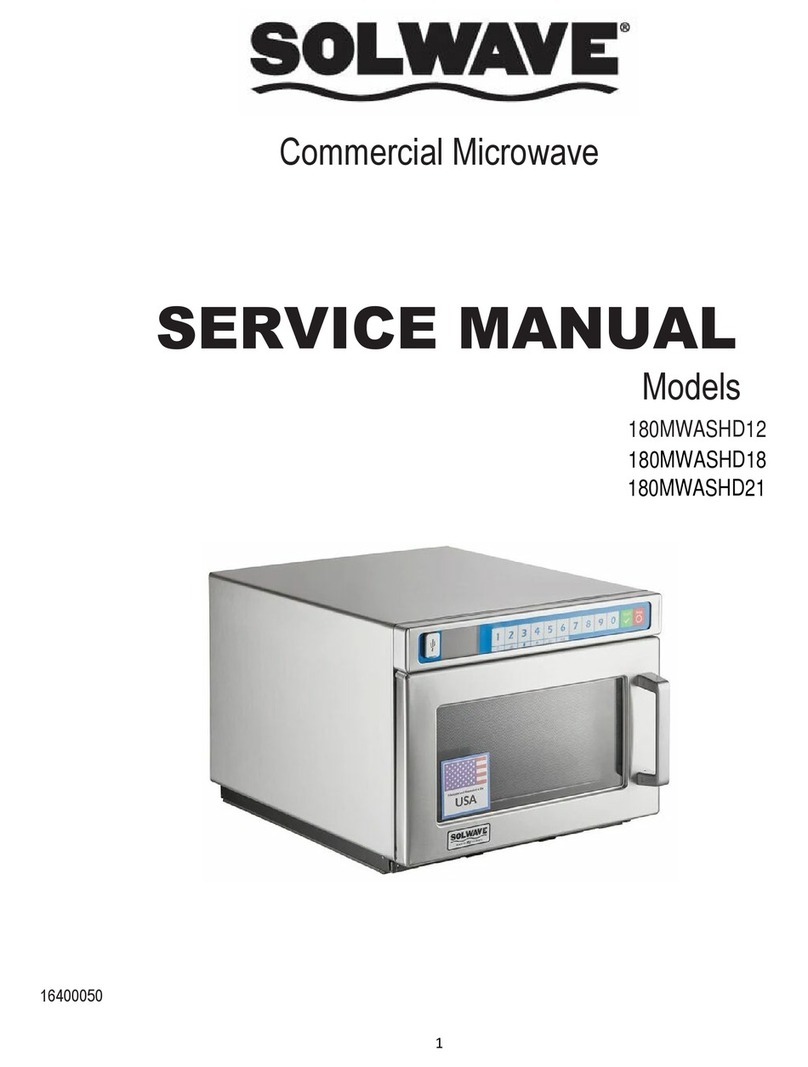
Solwave
Solwave 180MWASHD12 User manual
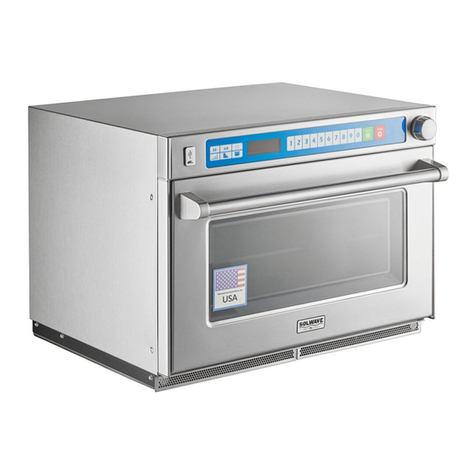
Solwave
Solwave SWAFP Series User manual
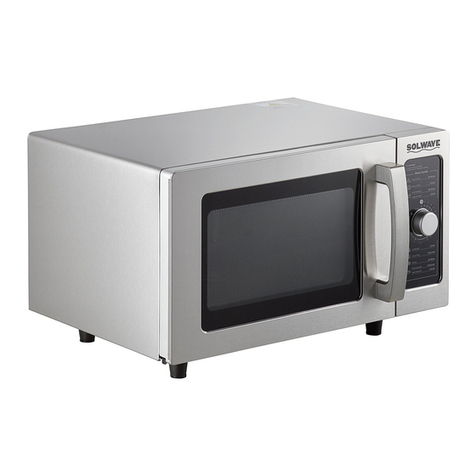
Solwave
Solwave 180MW1000D User manual
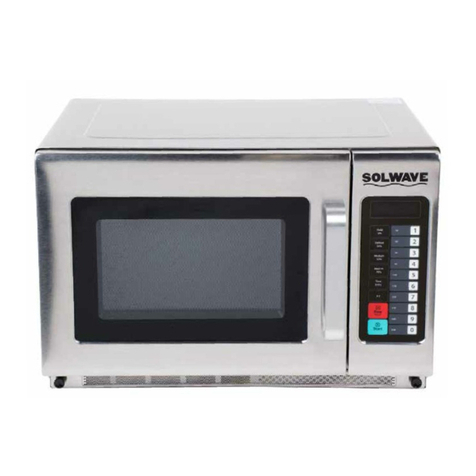
Solwave
Solwave 180MW1200T User manual
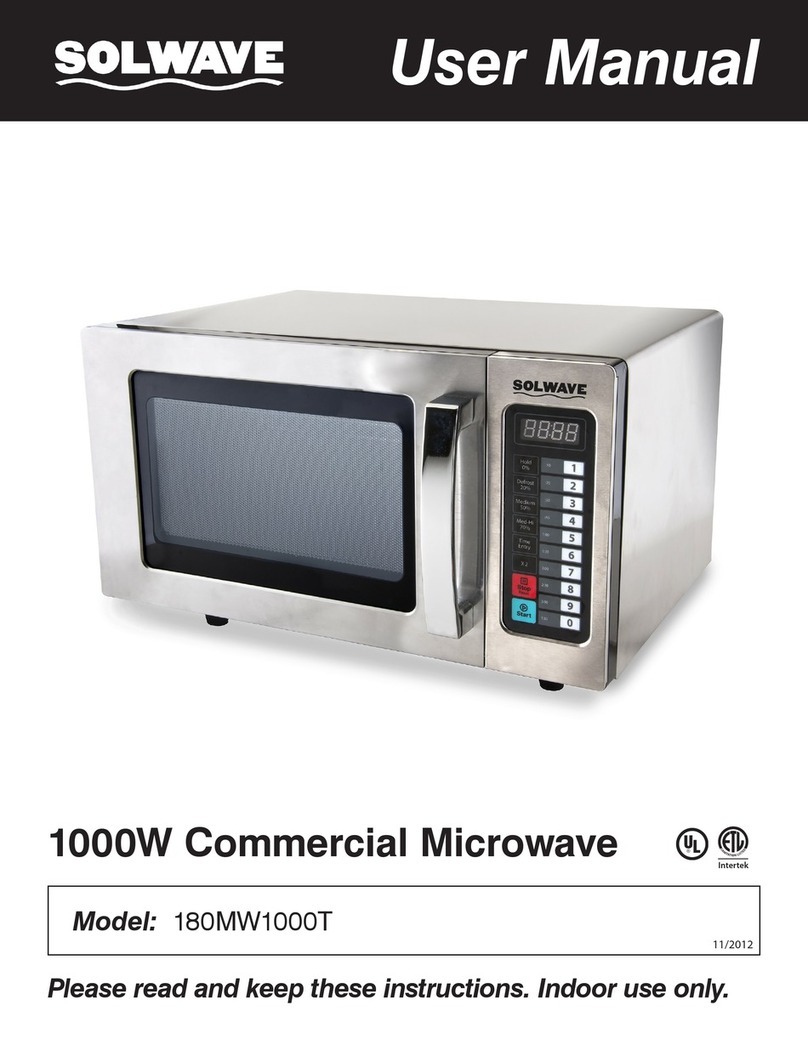
Solwave
Solwave 180MW1000T User manual
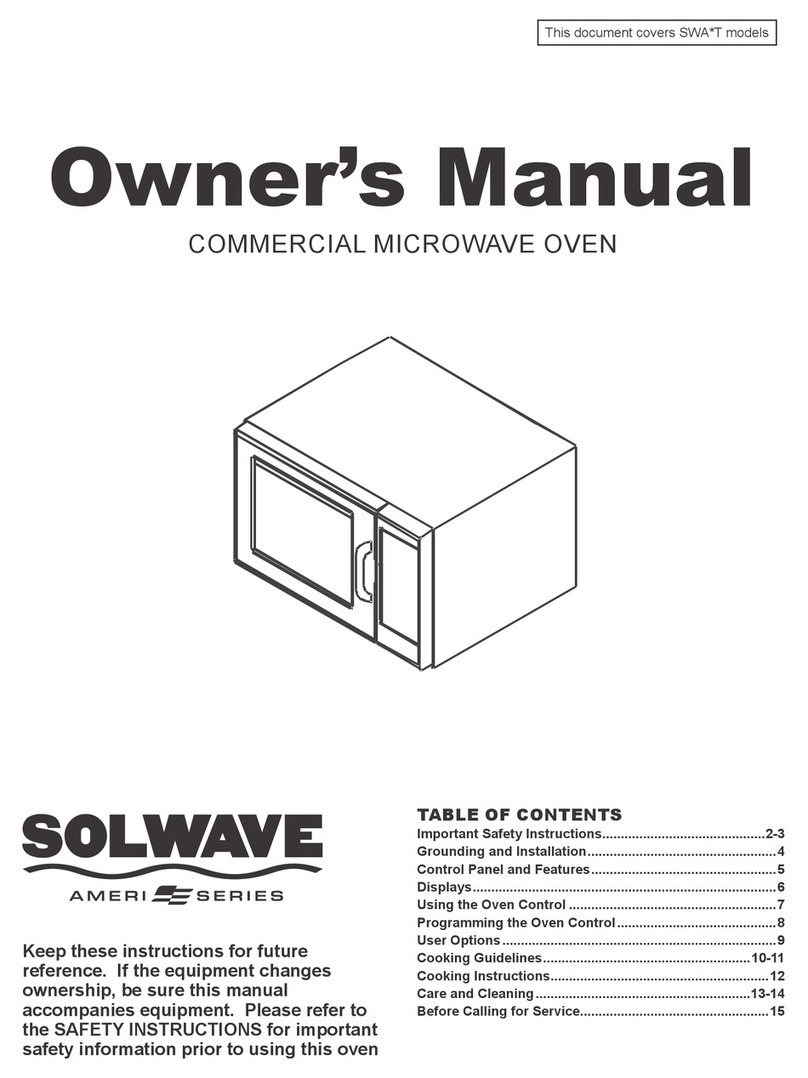
Solwave
Solwave SWA-T Series User manual
